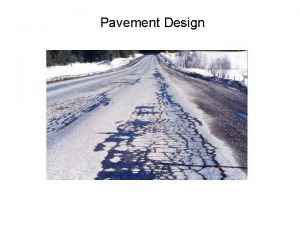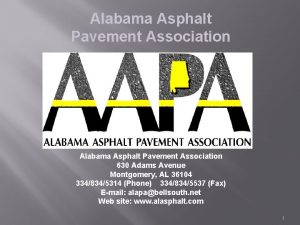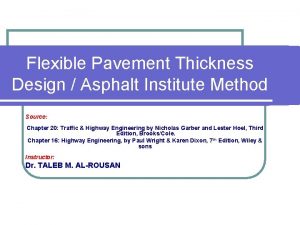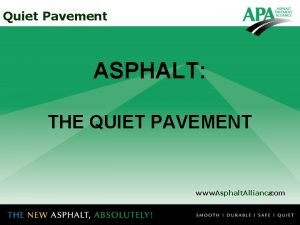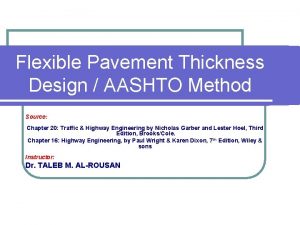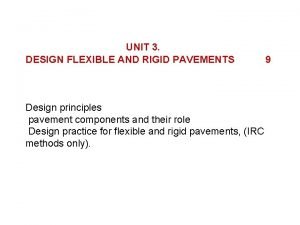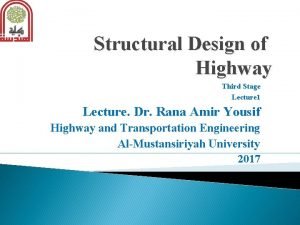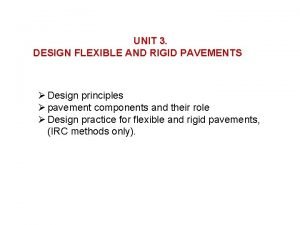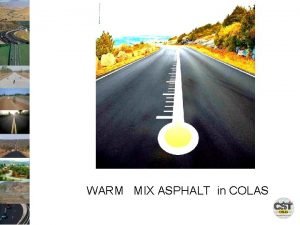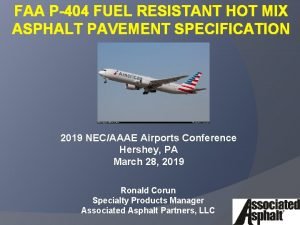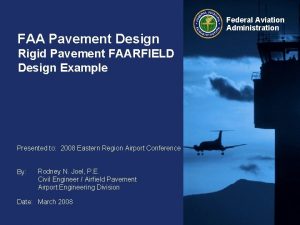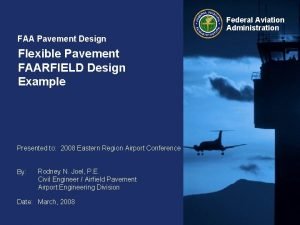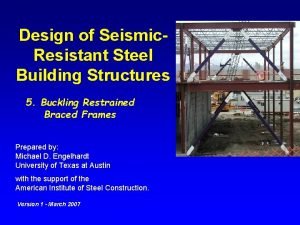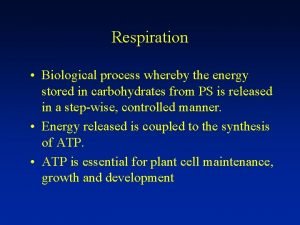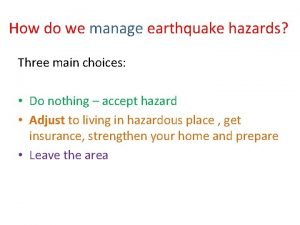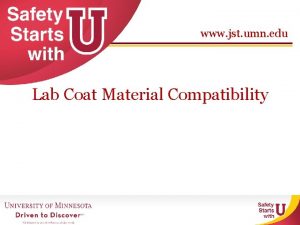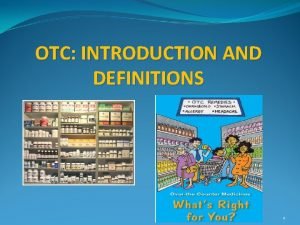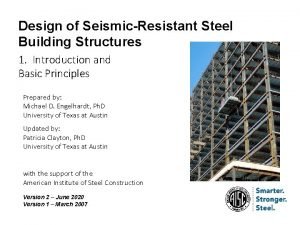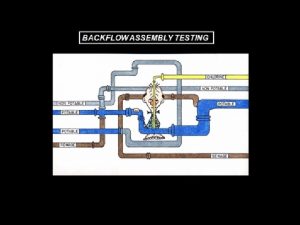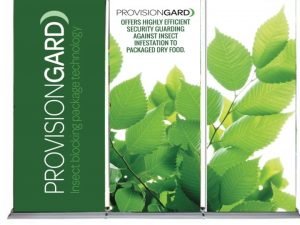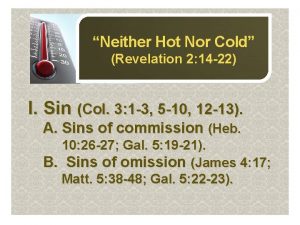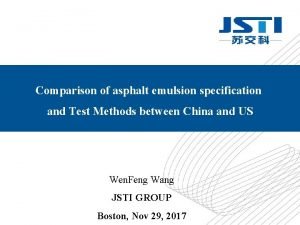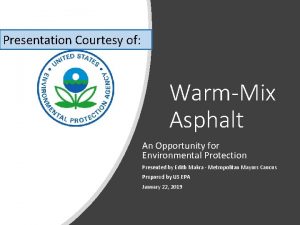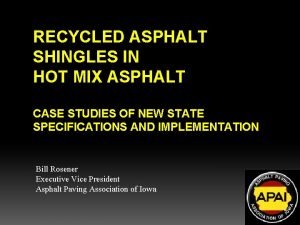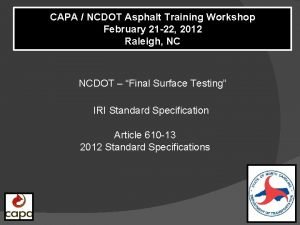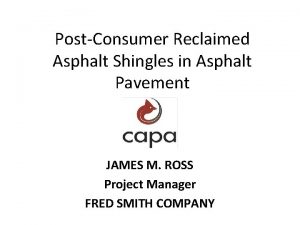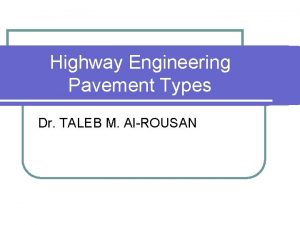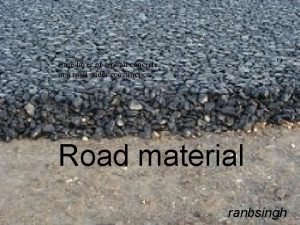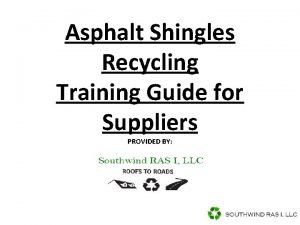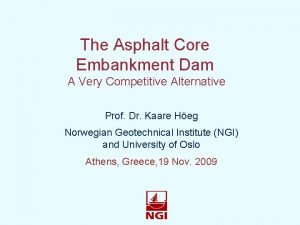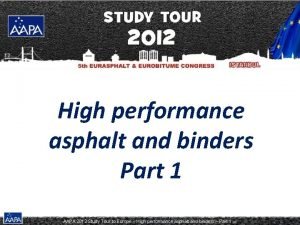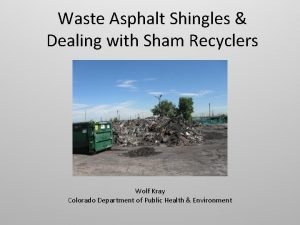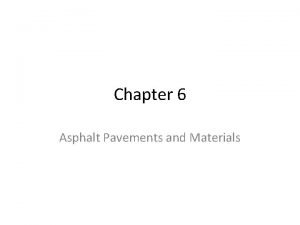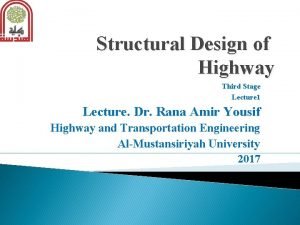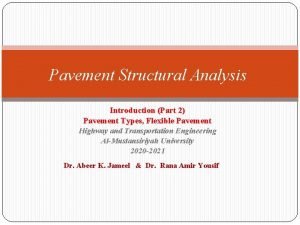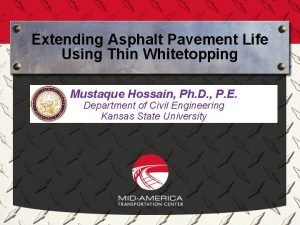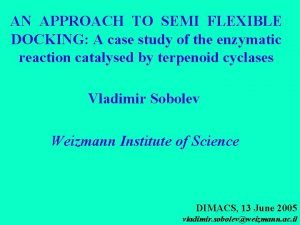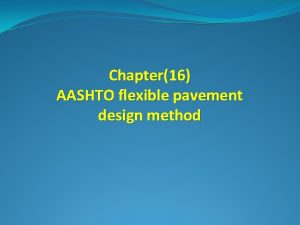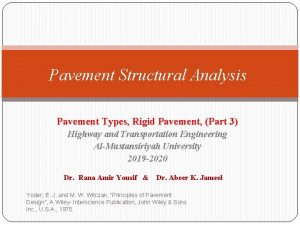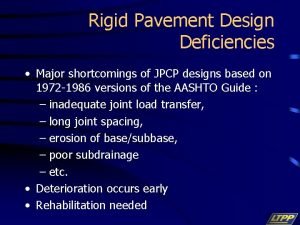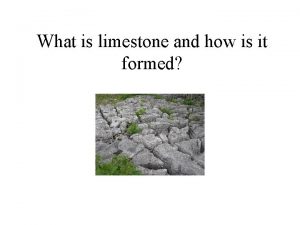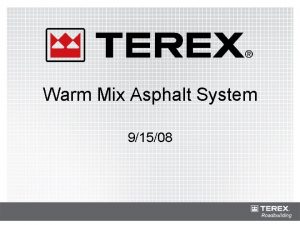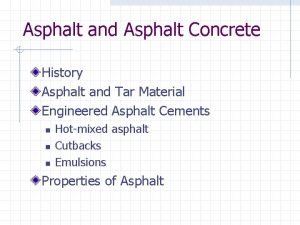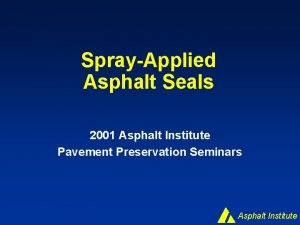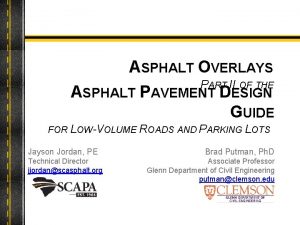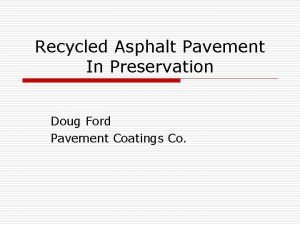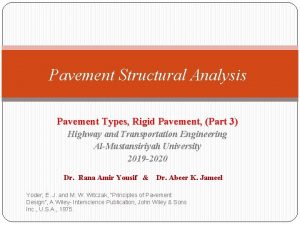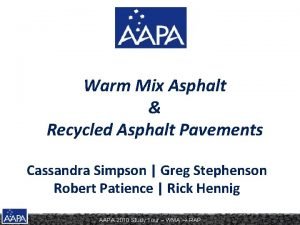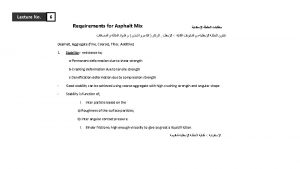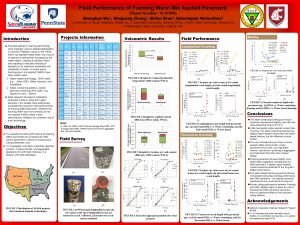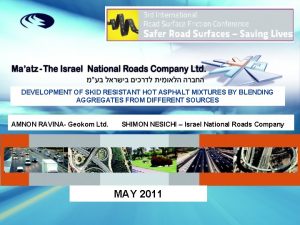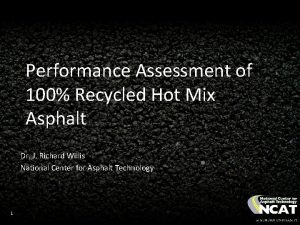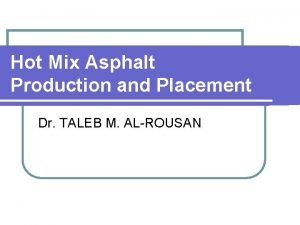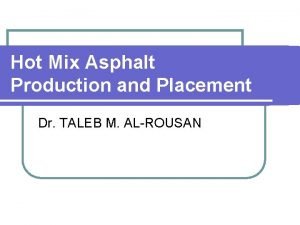FAA P404 FUEL RESISTANT HOT MIX ASPHALT PAVEMENT








































































- Slides: 72

FAA P-404 FUEL RESISTANT HOT MIX ASPHALT PAVEMENT SPECIFICATION 2019 NEC/AAAE Airports Conference Hershey, PA March 28, 2019 Ronald Corun Specialty Products Manager Associated Asphalt Partners, LLC

Background � Airports experience fuel and hydraulic oil spills on aprons and taxiways � Fueling operations � Aircraft sitting in Indentations in Taxiway GG at La. Guardia Airport queues � Softens (weakens) asphalt � Causes permanent deformations and failures

Fuel Resistant Pavement Sealers � Coal tar sealers are most commonly used to protect Hot Mix Asphalt pavements from fuel damage � Different coefficient of expansion for coal tar causes substantial alligator cracking within 2 -3 years � Cracking allows fuel penetration - short service life � Coal tar sealers are carcinogenic � MSDS – “Unusual Chronic Toxicity: May cause cancer of the skin, lungs, kidney and bladder. ” � Adding carcinogenic material to pavement that may be recycled – future exposure

Development of Fuel-Resistant PMA � Developed test to measure fuel resistance � Weigh 4 Marshall samples after compaction � Immerse in jet fuel for 24 hours � Remove samples from fuel bath, dry and weigh � Average weight loss of 4 Marshall specimens must be less than 1. 5%

Development of Fuel-Resistant PMA � Standard Hot Mix Asphalt mixture loses 10% weight from 24 hour soak in jet fuel � Standard Polymer Modified Asphalt (PG 7622) loses 5 -6% weight after 24 soak in jet fuel � Fuel Resistant PMA – less than 1. 0% weight loss

Fuel-Resistant PMA Usage � First Fuel Resistant Construction Project– La Guardia Airport in 2002 � Test section on Taxiway GG – 450 tons

Asphalt Pavement Analyzer (APA) - Rutting Evaluation of HMA - Moving wheel load (100 lbs) appli a pressurized hose (100 psi) whic on top of asphalt samples - Tested at 64 o. C for 8, 000 loading cycles - Computer data acquisition system

Stellar. Flex FR – Rut Resistance APA Rutting, mm 10. 2 12 10 6. 8 8 4. 3 6 1. 6 4 2 0 PG 64 -22 PG 76 -22 PG 82 -22 Stellar. Flex FR

Stellar. Flex FR Fatigue Test � Flexural Beam Fatigue Device, AASHTO T-321 �Tests mix’s ability to withstand repeated bending which causes fatigue failure �Data = number of loading cycles to failure (loss of stiffness) �Failure occurs when stiffness of beam < 50% of initial stiffness �Test parameters – 1000 micro strain, 15°C, 10 HZ

Stellar. Flex FR – Crack Resistance 45000 Flexural Beam Fatigue, Cycles to Failure 45000 40000 35000 30000 25000 20000 15000 10000 5000 0 4200 PG 82 -22 Stellar. Flex FR

Fuel-Resistant PMA Usage – La Guardia � Placed Fuel-Resistant PMA on Taxiway GG at La Guardia Airport August 2002 � Graded as PG 94 -22 � Pumped into plant at 330°F � Produced mix at 340°F � Placed in silo for 4 hours

Fuel-Resistant PMA Usage – La Guardia � Paved at 330°F � No problems with placement � Handwork and longitudinal joints look good � Density achieved � Paving crew could not see a difference in Fuel-Resistant PMA material from standard PMA

Fuel-Resistant PMA Usage – La Guardia Inspected fuel resistant pavement in October 2003 � Excellent condition � � No rutting � No cracking � No surface deterioration � 2018 – still performing well, only pavement at La. Guardia not rutted

Fuel Resistant Specification � Working with engineers at Mass. Port, developed generic specification for fuel resistant HMA � Minimum PG 82 -22 polymer modified asphalt ○ Pass fuel resistance test ○ Minimum 85% Elastic Recovery � Standard test method for fuel resistance � ½” P-401 Mix #3 ○ 50 blow Marshall design ○ Design at 2. 5% air voids � Result – asphalt mix with outstanding rut resistance, crack resistance, and durability that also resists jet fuel damage

Fuel-Resistant Usage – Logan Airport � First use of modified P-401 mix with FR binder at Boston Logan Airport

Fuel-Resistant Usage – Logan Airport � Placed 1300 tons of fuel resistant mix on Taxiway N and Runway 4 L 22 R at Logan Airport in June 2004

Stellar. Flex FR at Logan Airport

Fuel-Resistant Usage – Logan Airport � � � FR Asphalt graded as PG 94 -22 1/2” P-401 mix designed at 2. 5% air voids 7% asphalt content design target Mass. Port engineers concerned about rutting APA testing at Worcester Polytechnic Institute

Worcester Polytechnic Institute – APA Rut Testing APA Rutting, mm 4. 1 4. 5 4 3. 5 3 2. 5 2 1. 5 1 0. 5 0 3. 6 0. 9 3/4" P-401 Mix 1/2" P-401 Mix 3/4" FR Mix 0. 7 1/2" FR Mix

Logan P-401 vs FR Mix Asphalt Mix Performance Tester (AMPT)

Logan P-401 vs FR Mix AMPT Dynamic Modulus (STOA)

Logan P-401 vs FR Mix AMPT Dynamic Modulus (LTOA)

Logan P-401 vs FR Mix Traffic Level Million ESALs < 3 3 to < 10 10 to < 30 Minimum Flow Number Cycles General Rut Resistance --53 190 740 Poor to Fair Good Very Good Excellent AMPT Flow Number

Logan P-401 vs FR Mix Texas Overlay Tester

Logan P-401 vs FR Mix Texas Overlay Tester

Logan P-401 vs FR Mix Flexural Beam Fatigue

Fuel-Resistant Usage – Logan Airport Mix produced in drum plant at 340˚F � Placed at 325˚F without difficulty � Met density specification � Excellent surface appearance �

Stellar. Flex FR at Logan Airport

Fuel-Resistant Usage – New Projects � Boston, MA - Logan Airport � Alleyway Project – 2005 � Charlotte, NC - Douglas International Airport � Runway Project – Summer 2006 � Florida DOT � Truck Inspection Station – Summer 2006 � Boston, MA - Logan Airport � Alleyway Project – 2007 � Williston, FL – GA Airport � Apron project - 2015

Fuel-Resistant Usage – Charlotte Airport � Charlotte, NC - Douglas International Airport � Runway 18 L – 36 R � August 2006 � Night work – Runway available from 11: 00 pm until 6: 00 am � Mill 2” � Pave with 2” FR Mix

Fuel-Resistant Usage – Logan Airport

Fuel-Resistant Usage – Logan Airport

Fuel-Resistant Usage – Logan Airport

Logan Airport - 2014 De-icing at Logan Airport is done at the gates � Alleyway P-601 pavement in picture has been exposed to deicing chemicals for 12 winters – no visible damage to date �

Logan Airport - 2014 10 year old P-601 Pavement

Logan Airport - 2014 10 year old P-601 Pavement

Logan Airport – Why did the Joints Open Up?

Logan Airport - 2014 10 year old P-601 Pavement

FR at Logan Airport 9 year old Stellar. Flex FR Pavement

Logan Airport - 2014 10 Year Old P-401 Pavement with PG 76 -28

Logan Airport 2014 10 year old P-601 10 year old P-401

Logan Airport – May 2016 P-601 Pavement from 2004 Still in Place

Logan Airport – June 2017 Runway 4 L-22 R Repaved with P-401 Mix Containing PG 76 -28

Logan Airport – April 2018 One Year Later – Area has been Milled and Replaced

Logan Airport – Runway 4 L 22 R Repaved in 2017 with P-401 mix using PG 76 -28 binder � Rutted almost immediately � Milled and repaved rutted area in November 2017 with P-601 mix and PG 82 -28 FR binder � Fixed problem � Runway 4 L-22 R - August 2014

BWI Airport– Freight Apron � Paved in 2015 with 6” P-401 mix base layers and 2” P-601 surface course � Slight indentations appeared under parked air freighters (B-767, B 747) � Forensic analysis conducted to identify issue

BWI Airport– Freight Apron � It was suggested that additional compaction of P-601 mix occurred under static load of aircraft � Cored surface layer inside and outside of rutting – no difference in density of any of the cores � Very consistent densities – averaged 3. 2% air voids in indentations to 3. 1% air voids outside of indentations

BWI Airport– Freight Apron � Rutting occurs either from weak surface layer or weak underlying layers (pavement or subbase) � Straightedge identified no material pushed up around edges of rutting � Indicates problem with underlying layers

BWI Airport– Freight Apron � Full depth cores were cut and binder was extracted from each layer � Surface layer binder was PG 9422 FR binder meeting P-601 specification � All layers of P-401 mix contained PG 64 -22 binder

P-601 GA Project – Williston, FL Airport

P-601 GA Project - Herlong, Florida Fuel Spill Causes Discoloration, But No Damage to Stellar. Flex FR ® Pavement

P-601 for Bus Lanes Bus lanes have heavy, channelized traffic – rutting may be an issue � Oil and fuel leaks are also present � Logan Airport has used P-601 pavement in bus lanes to solve the problem �

FAA P-601 Specification � FAA was looking for alternative to coal tar sealers – projecting it would be outlawed in near future �Evaluated performance of Logan Airport Stellar. Flex FR mixes �Adopted Logan Airport FR specification as P-601 “Fuel Resistant Hot Mix Asphalt Pavement” specification in July 2014 � P-601 usage is eligible for FAA funding

FAA P-601 Specification FAA has adopted Advisory Circular # 150 / 5370 -10 G , dated 07/21/2014 � Contains specification item P -601 Fuel Resistant Hot Mix Asphalt (HMA) pavement �

FAA P-601 Specification � Asphalt Binder Specification �ASTM D 6373 Minimum grade of PG 82 -22 �ASTM D 6084 Elastic Recovery at 25°C ≥ 85% �ASTM D 7173 Maximum temperature difference of 4°C when using ASTM D 36 Ring and Ball apparatus � Mix Specification �P-401 ½” mix �Target air voids = 2. 5% � 50 blow or 50 gyration mix compaction regardless of aircraft type �Maximum Weight loss by fuel immersion 2. 5% as measured by test procedure in FAA P-601 Specification Section 601 -3. 3

FAA P-404 Specification FAA has issued Advisory Circular # 150 / 5370 -10 H on December 21, 2018 � Renumbers specification item P -601 Fuel Resistant Hot Mix Asphalt (HMA) pavement as P-404 �

FAA P-404 Specification � Asphalt Binder Specification � ASTM D 6373 PG 88 -22 or PG 82 -28 as dictated by climate � ASTM D 6084 Elastic Recovery at 25°C ≥ 85% � ASTM D 7173 Maximum temperature difference of 4°C when using ASTM D 36 Ring and Ball apparatus � Mix Specification Changes � Eliminates natural sand � Allows liquid-anti-strip, if needed � One freeze thaw cycle for TSR test � Adds APA rutting requirement ○ <10 mm @ 4000 passes, hose pressure 250 psi � Allowable lift thickness 1. 5” – 3” � Maximum Weight Loss Fuel Soak Test = 1. 5%

¾” FR Mix Development Despite demonstrated performance over time, many engineers are uncomfortable with a ½” mix (FAA Mix #3) that is currently in the P-601 specification � They believe a 3/4” FAA Mix #2 gradation is needed to withstand aircraft loadings on taxiways and runways � Associated Asphalt sponsored a research project at Rutgers University to see if a 3/4” FAA Mix #2 could be designed using P-601 criteria (FAA Mix #2 FR) � � Designed at 2. 5% air voids � Designed with 50 Marshall blows

¾” FR Mix Development Compared ¾” FAA Mix #2 FR version to standard P-401 Mix #2 � Compared to P-401 Mix #2 with best asphalt binder available – PG 82 -22 � Proposed AC 150 5370 -10 H recommends three grade bumps for heavily trafficked pavements – yields a PG 82 -22 in PG 64 -22 climate regions � Compared mix performance using multiple laboratory rutting and cracking tests �

¾” Fuel Resistant Mix FAA Gradation #2 Requirements and Research Study Gradation

¾” Fuel Resistant Mix � Asphalt Binders (true grade) �PG 82 -22: PG 83. 1 -25. 3 �Stellar. Flex FR: PG 95. 1 -25. 9

¾” Fuel Resistant Mix � Mix Design Results �Air Voids ○ FAA Mix #2 FR = 2. 5% ○ P 401 FAA Mix #2 = 3. 5% �Optimum Asphalt Content ○ FAA Mix #2 FR = 6. 7% ○ P 401 FAA Mix #2 = 5. 8% �Voids in Mineral Aggregates (VMA) ○ FAA Mix #2 FR = 17. 4% ○ P 401 FAA Mix #2 = 16. 3% �Fuel Resistance Mass Loss ○ FAA Mix #2 FR = 0. 31% ○ P 401 FAA Mix #2 = 5. 07%

¾” Fuel Resistant Mix Dynamic Modulus Master Stiffness Curve for Short-Term Oven Aged (STOA) Asphalt Mixtures

¾” Fuel Resistant Mix Dynamic Modulus Master Stiffness Curve for Long-Term Oven Aged Asphalt (LTOA) Mixtures

¾” Fuel Resistant Mix AMPT Repeated Load Flow Number Results

¾” Fuel Resistant Mix Asphalt Pavement Analyzer (APA) Rutting Performance

¾” Fuel Resistant Mix Federal Aviation Administration (FAA) Relationship Between High Pressure APA vs AASHTO T 340 ( Garg, 2017)

¾” Fuel Resistant Mix Beam Fatigue Cycles to Failure @ 800 microstrain__ P-401 Mix #2 - 45, 000 cycles FAA Mix #2 FR – 380, 000 cycles P-601 – 1, 000 cycles Flexural Fatigue Life for FAA #2 FR, P 401 FAA #2 and P-601 Asphalt Mixtures

¾” Fuel Resistant Mix IDEAL CTIndex Test Results

Benefits of FAA P-404 Mix with Stellar. Flex FR � Stellar. Flex FR highly polymer modified asphalt provides: � Outstanding rut resistance � Improved fatigue resistance � Resistance to fuel and oil damage – eliminates need for coal tar sealers � Excellent workability (Evotherm is included in formulation) � P-601 mix design has increased asphalt content, which provides: � Improved fatigue (cracking) resistance � Increased pavement life (durability) � Combination provides resistance to all potential airfield pavement damages – results in longer pavement life and lower life cycle cost

Questions?

 Standard axle load for pavement design
Standard axle load for pavement design Cbr method of pavement design
Cbr method of pavement design Alabama asphalt pavement association
Alabama asphalt pavement association Asphalt institute
Asphalt institute Quiet pavement
Quiet pavement Thickness of flexible pavement
Thickness of flexible pavement Asphalt pavement design example
Asphalt pavement design example Rigid pavement and flexible pavement
Rigid pavement and flexible pavement Difference between flexible pavement and rigid pavement
Difference between flexible pavement and rigid pavement Flexible pavement vs rigid pavement
Flexible pavement vs rigid pavement Colas liquid asphalt
Colas liquid asphalt Airport mix asphalt
Airport mix asphalt Faarfield
Faarfield Faa pavement design
Faa pavement design Product line and product depth
Product line and product depth Design of seismic-resistant steel building structures
Design of seismic-resistant steel building structures Cyanide-resistant respiration slideshare
Cyanide-resistant respiration slideshare Fire resistant cable thai yazaki
Fire resistant cable thai yazaki Tuned mass damper
Tuned mass damper Rodent resistant fiber optic cable
Rodent resistant fiber optic cable Clindamycin metabolism
Clindamycin metabolism Resistant materials tools
Resistant materials tools Flame resistant lab coat amazon
Flame resistant lab coat amazon Chapter 19 disease transmission and infection prevention
Chapter 19 disease transmission and infection prevention Fire resistant environmental ensemble
Fire resistant environmental ensemble Tamper proof packaging examples
Tamper proof packaging examples Collision resistant hash function
Collision resistant hash function Resistant ovary syndrome definition
Resistant ovary syndrome definition Arc resistant switchgear
Arc resistant switchgear Smrf
Smrf Spill resistant vacuum breaker
Spill resistant vacuum breaker Packaging
Packaging Collision resistant hash function
Collision resistant hash function Advantage of hot working process
Advantage of hot working process Perbedaan hot lava dan hot lava volcano
Perbedaan hot lava dan hot lava volcano Be either hot or cold
Be either hot or cold White hot vs red hot temperature
White hot vs red hot temperature China cationic emulsified asphalt
China cationic emulsified asphalt S&b asphalt
S&b asphalt Asphalt rolling pattern
Asphalt rolling pattern Asphalt and opportunity
Asphalt and opportunity Asphalt screed training
Asphalt screed training Determann asphalt
Determann asphalt Capa asphalt
Capa asphalt Fred smith asphalt plant
Fred smith asphalt plant Contained rock asphalt mat
Contained rock asphalt mat Asphalt base layer
Asphalt base layer Mixed asphalt shingle suppliers
Mixed asphalt shingle suppliers Core
Core Asphalt
Asphalt Delta tc asphalt
Delta tc asphalt Recycled asphalt colorado springs
Recycled asphalt colorado springs Asphalt
Asphalt Transverse joint
Transverse joint Flexible pavement cross section
Flexible pavement cross section Dr pavor
Dr pavor Nh road cross section
Nh road cross section Types of pavements
Types of pavements White topping concrete pavement
White topping concrete pavement Semi flexible pavement
Semi flexible pavement Aashto flexible pavement design example
Aashto flexible pavement design example Types of rigid pavement
Types of rigid pavement Jointed plain concrete pavement
Jointed plain concrete pavement Area that separates two-way traffic on an expressway
Area that separates two-way traffic on an expressway Pavement
Pavement Jpcp pavement
Jpcp pavement What is pavement evaluation
What is pavement evaluation Cross section of flexible pavement
Cross section of flexible pavement Guide and international signs
Guide and international signs Longnitudinal
Longnitudinal Carol ann duffy before you were mine
Carol ann duffy before you were mine Hendrina quinnen
Hendrina quinnen How are clints and grikes formed
How are clints and grikes formed

